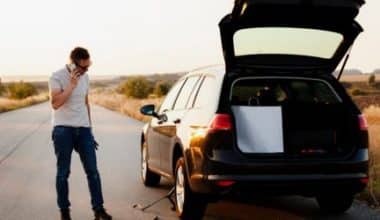Cheap car insurance might not seem like something that can apply to a new driver. But if you’re adding new drivers — namely teen drivers — to your car insurance policy, you can find options that won’t break the bank.
In fact, including a teen driver on your policy rather than buying a separate policy for them usually turns out to be the cheapest strategy.
How does car insurance work for new drivers?
There’s no specific auto insurance policy for new drivers. Each state sets its own minimum auto insurance requirements, and car insurance for new drivers will look the same as any other driver’s policy. While a lack of driving experience doesn’t change how much insurance you need, it will impact the price.
Does a new driver need insurance?
You’ll be expected to purchase at least your state’s minimum required coverage, which typically includes bodily injury and property damage liability car insurance. Some states also require uninsured/underinsured motorist coverage and personal injury protection.
Below are the standard types of car insurance:
Liability insurance
- What does it cover: Accident-related injury and property damage expenses incurred by other drivers and their passengers if you’re at fault for an auto accident. Also covers legal expenses, settlements and judgments if you’re sued after an accident.
- Who needs it: Liability insurance is required in every state if you buy a car insurance policy, including new drivers.
- Average monthly cost: $54
Liability car insurance pays others when you cause a car crash that results in damage or injuries to others. It also pays for your legal defense in case you’re sued because of an accident. Here are some examples of what liability insurance covers:
- You crash into your neighbor’s fence
- You rear-end someone at a traffic light and damage their car
- You cause a car accident and the other driver is hurt
Liability car insurance is required in every state, except in New Hampshire (where you don’t have to carry auto insurance if you can meet the state’s minimum financial responsibility requirements) and Virginia (where you can pay an uninsured motorist fee of $500 instead of buying car insurance). Even in those states, buying an auto insurance policy is the easiest way to ensure you’re well-protected if you cause a car accident.
The minimum required amount will vary depending on your state. It’s better to buy more than your state’s minimum. That’s because state minimums can be woefully inadequate if you cause an accident with multiple injuries. You’ll be on the hook for any medical expenses above your policy limits. You’ll want enough liability insurance to cover what can be taken from you in a lawsuit.
Uninsured motorist coverage
- What does it cover: Medical and injury-related expenses for you or your passengers if you’re in an accident with an uninsured driver. May also cover damages to your vehicle, depending on your state.
- Who needs it: Drivers who live in states that require drivers to carry uninsured motorist insurance. May be especially helpful to those who don’t have health insurance to cover their medical costs if injured by an uninsured driver.
- Average monthly cost: $17.
Uninsured motorist (UM) insurance and underinsured motorist (UIM) insurance pay for your medical expenses if someone crashes into you who has no insurance or not enough. This coverage does not pay the driver who’s uninsured.
UM can also pay for your medical expenses if another driver’s insurance denies coverage or goes out of business.
UM coverage pays for:
- Medical bills of you and/or your passengers
- Lost wages if you can’t work due to injuries from a car accident
- Pain and suffering
- Funeral expenses
- Car damage, depending on your state
Uninsured motorist insurance is required in some states. In other states, your car insurance must offer you this coverage, but you can typically reject it in writing. UM is generally a good coverage to have. You’ll usually purchase UM in coverage amounts that match your liability insurance. It is a good car insurance policy to have for new drivers.
Collision and comprehensive insurance
- What does it cover: Collision insurance covers damage to your own vehicle after a collision, such as with another vehicle or a pole. Comprehensive coverage pays for specific damage caused by non-collision events, such as theft, floods, fire, falling objects, and vandalism.
- Who needs it: Those who have a financed or leased vehicle and car owners who want insurance protection for their vehicle.
- Average monthly cost: $96 (separately, $66 for collision and $30 for comprehensive coverage).
If you want coverage for car repair bills, collision and comprehensive insurance cover a wide range of problems. They’re often sold together. If you have a car loan or lease, your lender or leasing agent will likely require you to carry both of them.
If you file a claim under one of these types of auto insurance, your insurance claims check will be reduced by your deductible. For example, if you have a $500 deductible and your car repair bill is $2,000, your insurance check will be $1,500.
Medical Payments (MedPay)
- What does it cover: Accident-related medical bills for you and your passengers, regardless of who was at fault.
- Who needs it: Drivers in Maine, New Hampshire and Pennsylvania.
- Average monthly cost: $3
Medical payment coverage, sometimes called MedPay, covers medical bills for you and your passenger for injuries suffered in a car accident, regardless of who caused the accident. It’s usually sold in small amounts of coverage, often between $1,000 to $5,000. MedPay is not available in every state.
Personal Injury Protection (PIP)
- What does it cover: Accident-related medical bills for you and your passengers, regardless of who was at fault. Also covers related expenses, like lost wages, rehabilitation costs, and funeral expenses.
- Who needs it: Drivers in Delaware, Florida, Hawaii, Kansas, Kentucky, Maryland, Massachusetts, Michigan, Minnesota, New Jersey, New York, North Dakota, Oregon, and Utah must buy PIP. It is also a good car insurance policy for new drivers.
- Average monthly cost: $21
Personal injury protection (PIP) coverage is similar to MedPay and covers medical expenses for injuries suffered in a car accident for you and your passengers, no matter who caused the accident. PIP generally pays for:
- Medical bills for car accident injuries
- Lost wages if you cannot work due to injuries
- Rehabilitation costs
- Replacement services for things you can’t do because of injuries, like child care or cleaning services
- Funeral expenses and survivor benefits
Many states require PIP and it’s sometimes part of the “no-fault auto insurance” laws, which generally require you to make smaller injury claims on your own PIP insurance. PIP is optional in some states and not available in others.
Who needs new-driver car insurance?
Although there’s no special kind of car insurance for new drivers, rates for inexperienced drivers are usually higher than those for more seasoned drivers.
Insurers generally categorize new drivers as:
- Teenagers who just got a driver’s license.
- Adults who are driving for the first time.
- Immigrants and foreign nationals.
- Drivers of any age with a gap in driving or insurance coverage.
Teenagers
Auto insurance companies charge higher rates for teenage drivers because they’re more likely than any other age group to be in an accident. The best way to get cheap car insurance for a teen driver is for the teen driver to be added to their parent’s or guardian’s policy, as long as they share the same permanent address.
Beware that “cheap” is relative — adding a teen to a married couple’s policy may increase the couple’s rate, too. However, an insurance policy is mostly priced based on the primary driver, so a teen going it alone is likely to pay much more expensive premiums and will miss out on discounts for having multiple drivers and cars insured under one policy.
You can compare multiple new-driver insurance quotes online to be sure.
How teens and young drivers can get cheaper car insurance
Some good news: Insurance companies offer plenty of discounts for students and young drivers, and rates will get better over time with safe driving.
Insurance rates typically get cheaper around age 25, provided the driver has a few years of experience under their belt.
Immigrants and foreign nationals
Even if you have a long history of safe driving in another country, insurance companies consider you a new driver if you have no U.S. driving history. They access only domestic driving records when setting rates, so your driving history in the U.S. is all that counts. This also goes for your credit history, which is used to calculate auto insurance rates in many states.
Without a valid U.S. driver’s license, you may have a harder time getting an insurance policy, even if you have an international driver’s permit. However, most major insurers do insure people with foreign licenses or international driver’s permits, as long as their state of residence accepts these as valid driver’s licenses. If you’re renting a car, the easiest option may be to use the rental car company’s coverage.
If you plan on staying and driving in the U.S., you’ll need a driver’s license in the state where you live. Some states, like California, will issue a driver’s license regardless of immigration status. Once you have your license, get at least three auto insurance quotes so you can choose the best rate and coverage.
People with a driving or coverage gap
Your license could be expired because you spent some time abroad, or your lifestyle doesn’t require any driving. If you don’t have a driving history to check, insurers can consider you a new driver. And without continuous auto coverage, they may consider you a high-risk driver, which can increase car insurance rates.
Even if you have some driving history, if you’ve had a gap in coverage at all, you’ll likely pay more for insurance, so it’s important to shop around for the best rates. Some companies make an exception for military deployment, so check with your insurer if that applies to you.
Since continuous coverage is one of the most important factors auto insurers consider, some may not accept your application if you’ve had gaps between policies. If that’s the case, you can look for high-risk insurance companies that specialize in coverage for people having a hard time getting insured.
Best car insurance providers for new drivers
Nationwide
Nationwide offers a wide variety of coverage options, backed by strong financial performance and very few reported customer complaints. A.M. Best gave Nationwide an A+ (Superior) rating for financial stability, while the National Association of Insurance Commissioners (NAIC) noted “minimal” complaints.
Nationwide’s five main coverage options are highly customizable versions of classic coverage types:
- Collision: pays for damage to the teen’s vehicle
- Liability (required): pays for damages to other cars and drivers
- Comprehensive: pays for damage that occurs during non-driving incidents (like theft or weather damage)
- Underinsured/uninsured motorist: pays for damage caused by someone without applicable insurance
- Rental car reimbursement: covers alternate transportation if the car can no longer be driven
However, Nationwide realizes the needs, liabilities and price points of younger drivers might be different, and has adjusted its discount offerings to target this group. The five main discounts afforded to young drivers are:
- SmartRide: tracks driving in real time to offer discounts
- SmartMiles: cuts down the cost of your coverage depending on how much you drive
- Good Student discount: available for drivers 16-24 with a B average or better
- Safe Driver discount: available for drivers with five years of safe driving
- One-time discount for signing up for automatic payments
Progressive
Progressive’s online interface includes an app and a mobile-responsive website. You can file claims online, chat with an agent or a customer service representative and even attach photos of your accident within the app to help speed up your claims process. Claims payouts are also online, with an auto-deduction feature linked to your bank account.
In addition to its digital features, Progressive offers discounts and bundling options geared toward the younger driver. They’ve developed the Snapshot program, which monitors bad driver habits like distracted driving and rewards safe driving with coverage discounts. Progressive also offers cost-cutting bundles for families, offering home, life and auto insurance as a package.
Although its premiums aren’t the lowest you’ll see on this list, the discounts and digital convenience may appeal to a young driver. The mobile app offers account management and payment, roadside assistance, claim reporting and quotes.
The website itself is also helpful, offering a digital user portal and lots of other information on Progressive quotes, claims and frequently asked questions.
Allstate
Car insurance companies have found that offering discounts is an effective way to drive business with a younger demographic, and Allstate is no exception. The company promotes multiple discounts, programs and incentives geared towards the younger driver.
Top discount options include:
- Multiple policy/bundling discounts for different kinds of coverage, like home or renters insurance
- New car discount, if you’re the first owner of your new vehicle
- Anti-lock brakes and anti-theft device discounts
- EZ pay plan and eSmart discounts when you set up automatic withdrawal and/or opt for paperless billing
- FullPay or Early Signing discounts when you pay in full or sign your policy a week before it goes into effect
- Responsible Payer discount if you have paid on time for the past year
- Safe Driving Bonus for drivers who go 6 months or more without an accident
While some of these discounts can appeal to drivers of any age, they can be especially valuable for drivers who are just starting their on-the-road experience.
Liberty Mutual
Liberty Mutual tops the customer service charts due to its helpful agents. Customers can file claims over the phone, 24/7. Liberty Mutual also offers a variety of specific and unique discounts for everything from getting a quote before your current policy expires to going on autopay or paperless account management.
Another customer-friendly feature is Liberty Mutual’s deductible fund, which makes contributions to deductible payments. Liberty Mutual contributes $70 per year, while you add $30. If you have an accident, whatever has been built up in the fund goes toward your deductible. There’s also RightTrack, the usage-based insurance gadget and app that can lower your rates based on mileage and driving habits.
Like others in the industry, Liberty offers a variety of discounts targeted at different ages, demographics and driving records. Liberty Mutual customers also have the opportunity to bundle their car insurance with other kinds of policies, including homeowners and renters insurance.
Geico
Geico advertises itself as the best car insurance for young drivers, and in many cases, that may be true. The company offers lower rates for young men than most of its competitors, which could make it more attractive on a per-quote level, depending on your needs.
In addition to lower premiums, you can customize your policy with discounts like:
- Good Student discount: requires a B average or better
- Good Driver Discount: requires five years of accident-free driving
- Driving class discount: requires taking a defensive driving class
- Membership discounts: for belonging to various student organizations
Geico also receives an A++ financial stability rating from A. M. Best and offers in-person agents in addition to a robust app and website. In the J.D. Power Carrier Switching Trends study, Geico was the most popular option for those switching providers.
Although Geico’s rates can be low, qualifying for them might be difficult depending on several factors, including where you live, your age, your driving record and even the kind of car you drive.
Pricing factors in a car insurance quote
New drivers have some of the highest car insurance rates, but age and driving history aren’t the only things insurance companies consider when setting rates. Factors that affect car insurance quotes include:
- Personal characteristics. This includes your age, gender and marital status.
- The coverage you choose. The more liability coverage and additional options you have, the higher your insurance rates are likely to be.
- Your vehicle. Your car’s make and model, safety features and likelihood that it’ll be stolen all affect your rate.
- Your location. Every state has its own minimum car insurance requirements; factors like your neighborhood’s crime rate and population density will also affect your insurance price.
- Your credit score. Drivers with poor credit typically have higher car insurance rates in states where pricing based on credit is allowed. California, Hawaii and Massachusetts don’t allow insurers to use credit when determining car insurance rates.
How to save as a new driver
While new drivers will typically pay more for coverage than those with more experience on the road, there are still ways to save on a policy.
Shop around. Rates can differ tremendously depending on the insurer you use. To make sure you find the best possible price, compare quotes from at least three insurance companies. And continue to shop around each year — just because you had the cheapest rate a year ago doesn’t mean you still do.
Stay on a family auto insurance policy. If you have the same permanent address as your parents or guardians, compare rates for a stand-alone policy and then compare that to what it would cost to stay on your family’s insurance. It might cost less to stay on your family’s policy.
Look for discounts. Many auto insurers offer discounts that new drivers can take advantage of, including:
- Good student discount.
- Discount for young drivers who take a defensive driving course.
- Student away-from-home discount (if you are on your parents’ policy).
- Multipolicy discount if you have renters or homeowners insurance.
- Military or occupation discount.
- Safety equipment discount.
Recommended Articles
- Best & Cheap Car Insurance In Tucson 2023
- BEST CHEAP CAR INSURANCE IN KENTUCKY 2023
- HOW TO SHOP FOR CAR INSURANCE: Easy Methods & Steps
- Best Car Warranty Companies For 2023: Reviewed
- Car Insurance Calculator: How To Estimate Your Cost
- HOW TO SAVE MONEY CAR INSURANCE: Proven Tips & Steps
- Business Insurance Quotes: Getting Insurance Quote Online






